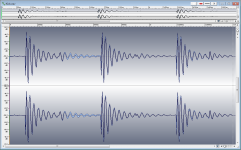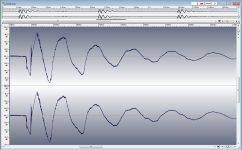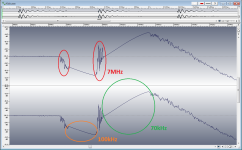For music delivery, I agree. But it's a other thing for recording and production. Although I wouldn't bother with a sample rate above 96K, someone might have reason to. And recording at 24 bits is certainly very useful. Editing can/should be done at 32 or 64 bit float.The whole debate about 16 / 24bit and 44.1 to 192k is pointless.
But once the production is all done? 44.1/16 is fine. I like 48K better, but don't have a real rational reason for it. Maybe a throwback to DAT.
It's the same for video. The higher bitrates and color resolution are important for production work. Once the video completed and distributed, they are far more practical formats.
@diyralf. I'm not so sure, how is it that people have perceived a difference between these preamps Can you hear a difference between 2 solid state preamps? one which seems to be mostly regards clarity and transients, sibilance of vocals for example?
@diyralf. I'm not so sure, how is it that people have perceived a difference between these preamps...
True.
In the case of recordings, if you happen to have a very high quality high res recording (not CD audio upsampled then sold as hi res), its easy enough to download an audio editing program then down-sample, dither and truncate to 16/44 and see if the result sounds as good as the original hi res file.
A brief warning, if using Windows one has to be very careful not to let it resample one's audio on the fly without asking or informing the user. The real-time resampler in Windows Audio Engine is not very good, makes everything it touches sound worse. For info on avoiding that problem: https://www.diyaudio.com/forums/digital-line-level/314935-es9038q2m-board-410.html#post5731319 (post #4093 in that thread).
...in addition to what is described there, while it is useful to turn down Windows software volume control enough to prevent intersample-over distortion, best not to use any software volume control beyond that since it reduces resolution. The volume control registers in Sabre dacs are better in that they are dithered so that resolution is not lost. However, the noise floor level is fixed in that case so turning down the volume will not turn down noise. A hardware volume pot after the dac can potentially turn down the audio volume and noise floor at the same time (although pots have their own problems 🙂 ).
Last edited:
This pdf is about the limits of a technology.Some scientific based opinion on the matter from Dan Lavry (Lavry Engineering DAC's) is found here: http://www.lavryengineering.com/pdfs/lavry-white-paper-the_optimal_sample_rate_for_quality_audio.pdf
He think 60KHz is the optimal sample frequency, and in modern systems the closest optimal frequency to it availble is 88.2kHz. Why you can read in the PDF.
But we apply this technology to humans.
What is the difference between the lowdest sound we can hear and the softest sound we can hear?
The softest sound we can hear is the sound of blood flowing through your ears. The loudest sound we can hear just before permanent hearing damage is about 120 spl.
But that is not the dynamic range of human hearing. Play a loud sound and a soft sound back to back with a 1 second interval, and you'll be lucky if you get a 60dB audible difference. And this 60dB is much closer to real dynamic range of human hearing.
So the CD standard is huge overkill in this department.
How much audible stuff is there in music above 10kHz?
I can make a sound file with a phase linear 96dB/oct high pass filter at 10kHz. Just give/show me a file that I can process and upload here. The higher the resolution the better of course.
Anyone up for a shock, or do you already know the result.
AES E-Library >> A Meta-Analysis of High Resolution Audio Perceptual Evaluation
The comments of this publication are interesting.
And this 60dB is much closer to real dynamic range of human hearing.
So the CD standard is huge overkill in this department.
Then how could it be that back in the early days of CDs sometimes they were not dithered and some people could hear the resulting truncation distortion at the bottom of the 16th bit (-96dBFS)?
Its not hard to show that some people can hear distortion at lower levels than that, its not like the people who heard the truncation distortion were all at the exact maximum limit of human perception.
Last edited:
A sine at 10k may look like a sine, but that is due to interpolation, if my technical understanding is correct (and interpolation is essentially an educated guess at where the extra sample points should be)
Does that mean interpolation can reconstruct a complex wave as opposed to a sine? It's hard to answer without testing, and testing that would be difficult too (for me at least)
Converting samples to continuous waves (what a DAC does) it's like solving a puzzle: The DAC must find a solution composed of an infinite sum of sine waves whose frequency can range from 0 to half the sampling rate (let's say 22 kHz for CD). That infinite sum of sine waves must pass through all the samples and if the original signal was filtered below 22 kHz, the sampling theorem ensures that the solution is unique and it is identical to the original sampled signal. No matter how ugly it looks in sampled form, the reconstructed signal will be an (almost) identical copy of the original signal.
Theoretically, for a 10 kHz sine wave, a sampling frequency of 20 kHz is enough (that equals to two samples per cycle). In the real world 22 kHz would actually be required.
I have the same Technics Player. It still works!
Your consideration is irrelevant. Imagine you have 16 bits. That's 65536 data points. Imagine your volume knob has 65536 settings. Do you really think that you can hear a difference at 30,000 and 30,001? The whole debate about 16 / 24bit and 44.1 to 192k is pointless. The ear just can not hear better. The music quality is determined by instruments, room acoustics, etc., not by technology, where bats still hear something. The whole thing is forced by the industry and magazines who want to earn money again and again.
My consideration?
I didn't say I could hear the difference in bit depth.
But I can hear the difference in sample rate.
FWIW I rarely ever use 44.1kHz, even the small change to 48kHz is noticable under some conditions
Besides, anyone who has studied computing or telecoms will or should understand that the Shannon Niquist equation represents an absolute minimum sample rate requirement via a vis frequency response/ channel bandwidth
Back when CDs were new tech, and I was young, several audio publications performed tests of the CD players, transports and DAC, for data integrity (for want of the real term) and found that many of the top end players outputted something like 80% amplitude error, sample by sample.
Now I'm uncertain if back then oversampling was used universally, and certainly there were many type of DAC architecture used - the faster the DAC the less accurate, despite bit depth, due to less settling time.
Also ADCs had the same accuracy issues at high speed, due to the sample hold acquisition times required and the direct relationship between that time period and accuracy of measured values.
As far as DACs go, these days, that really isnt anything like the problem of old, at least not in the measurement and instrumentation world - and in my sphere of experience.
Last edited:
There is little difference between 16 & 24 bit depth for direct content.But once the production is all done? 44.1/16 is fine. I like 48K better, but don't have a real rational reason for it. Maybe a throwback to DAT.
As my professor friend easily explained it...
16 bit depth is nothing to do with inadequate resolution per se, filters, dithering, you name it, NO, it's simply inadequate for reverb.
The main reason why the CD standard was an altogether lousy compromise.
It truncates the reverb, making it extremely difficult to reproduce a natural acoustic or do meaningful convolution techniques.
End of argument.
Uber funny!
What is with the very new members that spend their time trolling?
Has there been lots of retirements and redundancy in the audio world lately?
What is with the very new members that spend their time trolling?
Has there been lots of retirements and redundancy in the audio world lately?
Last edited:
A hard strike on a kick drum generates content well into the MHz range due to the steep non sinusoidal shock wave generated.
Most probably a byproduct of mic/preamp distortion as in this kick drum recording (16bit/44.1kHz wav)
Gearslutz - View Single Post - Kick Drum Waveform + example: Should it look like this?
The bandwidth numbers shown is the result of applying the formula BW=0.35/RT
https://www.edn.com/electronics-blo...-The-bandwidth-of-a-signal-from-its-rise-time
George
Attachments
yes, ignorance is a good stock in trade here.Uber funny!
It was Prof Schneider (CNRS) who explained it so simply.
That comes from the University of Strasbourg, and the sound engineers course. (PRIMUS)
It was one of the best university course training sound engineers in Europe.
France also has IRCAM, who would confirm the analysis as completely correct.
(re bit depth and inability to resolve reverberation at 16 bit depth)
Those trying to criticise such excellent analysis, well go and show you can do better.
Maybe you did this masterpiece?
How many first class sound engineers did you train?
How many world class auditoriums did you engineer for acoustics?
Sorry but I look at this forum commentary with real dismay.. 🙄
Is ignorance now regarded as such wonderful virtue ?
Attachments
Last edited:
The more puzzling thing is how a 44.1kHz sampled signal can resolve the claimed 7MHz distortion format to be seen in an audio tracker suite.
Possibly an encoding artifact?
6Vheater,
I have stated that I dont believe I can hear the change in bit depth directly, between 16 and 24bit.
But it is not by any means an absolute truth (that is is inaudible).
I do know that rendering from 32 bit FP when mastering, saves data loss, or some other tech aspect of down sampling, and has always resulted in better quality recordings, even at 16bit 44k, in my amateur recordings.
Personally I'd still like to get around to visiting Birmingham Symphony Hall, which is one of the most interesting acoustically designed buildings I have read about/seen film of.
Possibly an encoding artifact?
6Vheater,
I have stated that I dont believe I can hear the change in bit depth directly, between 16 and 24bit.
But it is not by any means an absolute truth (that is is inaudible).
I do know that rendering from 32 bit FP when mastering, saves data loss, or some other tech aspect of down sampling, and has always resulted in better quality recordings, even at 16bit 44k, in my amateur recordings.
Personally I'd still like to get around to visiting Birmingham Symphony Hall, which is one of the most interesting acoustically designed buildings I have read about/seen film of.
Last edited:
Clearly, not many are familiar with the principles of modern digital audio recording. Particularly with the digital filter functions made possible by oversampling during the recording process and again during playback. Playback oversampling is not simple interpolation. Noise is also an important tool for improving accuracy. I'm sure there are many good references but my favorite is
Principles of Digital Audio by Pohlmann, Ken C. Paperback Book The Fast Free 9780672226342 | eBay
Principles of Digital Audio by Pohlmann, Ken C. Paperback Book The Fast Free 9780672226342 | eBay
Really? Do you have links or citations on this? I worked at IRCAM when the CD was young and I don't remember anything like that. But IRCAM is a big place, so I could have missed it.France also has IRCAM, who would confirm the analysis as completely correct. (re bit depth and inability to resolve reverberation at 16 bit depth)
IME, once the listening room is very quite, 16 bit recordings have amazing low level details. There are all sorts of tails and fades that you normally don't hear in typical listening room. Would 24 bit be even better? I dunno - but I do know that most listening environments cover up the lowest levels of 16 bit. MP3 for sure takes away ambient cues. That's my cheat for telling if it's compressed. Of course low bitrate MP3 is obvious.
Applying the formula and getting the result wrong by a factor of 1000, you mean! How dumb, this is a complete howler of a mistake. The mike preamp obviously overloaded into slewing on a timescale of several ms, and slewing recovery is ringing at about 7kHz.The bandwidth numbers shown is the result of applying the formula BW=0.35/RT
https://www.edn.com/electronics-blo...-The-bandwidth-of-a-signal-from-its-rise-time
George
But I can hear the difference in sample rate.
You have to be a medical wonder. What is the difference between 44.1k and higher sampling rates? At 44.1k you hear all frequncies up to 22k. At 88k or higher you have all audible frequencies and all inaudible frequencies. Nyquist proves that 44.1k is completely sufficient. Higher sampling frequencies are for the dustbin.
- Home
- Source & Line
- Digital Source
- Are 24bit/192KHz music files really better than the CD standard?





